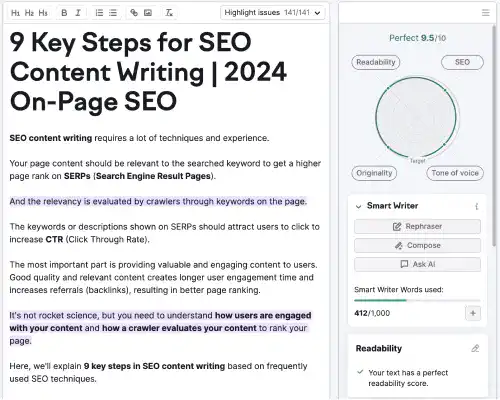Conducting a Comprehensive On-Page SEO Quality Review

Understanding Google's Content Guidelines
Google provides web page content guidelines – Creating helpful, reliable, people-first content.
Google's guidelines for web page content emphasize the creation of helpful, reliable, and user-centric content.
The fundamental aim is to cater to the needs and interests of users rather than merely optimizing for search engines.
These guidelines underscore the importance of content quality, which significantly influences search rankings.
Given the constraints of time and resources, it is practical to focus on specific aspects of your content to maximize its impact. Below are four critical areas you should consistently evaluate to enhance the quality of your on-page content.
Grammar and spellcheck
At the very least, your content should be free from grammatical errors and spelling mistakes. These are the minimum requirements for any professional website.
Tools like Grammarly can help automate this process, providing quick and reliable corrections that would otherwise require a meticulous manual review.
The tone of voice consistency check
Maintaining a consistent tone of voice throughout your content is crucial, especially when addressing complex topics or long-form articles.
The tone should be tailored to your target audience and must remain consistent across all pages to avoid disorienting your readers.
Tools like Semrush’s SEO Writing Assistant can aid in analyzing your tone and suggesting adjustments to align with your desired audience engagement.
Semrush SEO Writing Assistant

Visual check
The visual aspect of your content plays a significant role in engaging users.
A well-structured text layout, complemented by appropriate themes from CMS platforms like WordPress or well-crafted HTML and CSS, can enhance readability and user engagement.
Factors to consider include font size, font family, spacing, image placement, and overall layout coherence.
Additionally, ensuring your site’s mobile optimization is crucial as the majority of users now access the internet via mobile devices.
Information reliability check (E-E-A-T)
Google has recently placed a stronger emphasis on the reliability of information through its E-E-A-T framework—Experience, Expertise, Authoritativeness, and Trustworthiness.
This framework guides publishers to produce content that is not only accurate but also authoritative and trustworthy. While meeting all aspects of E-E-A-T can be challenging, it is essential to strive towards providing information that users can rely on.
This includes citing credible sources, presenting evidence-based information, and establishing your or your organization’s expertise on the topic.
Conclusion of Chapter 9
In this chapter, we explored the essential techniques for creating optimized web content through effective on-page SEO strategies. Understanding the intricacies of keyword placement, content structuring, and user engagement is crucial for enhancing your site's visibility and performance on search engine result pages (SERPs).
Key Takeaways:
- Aligning with User Search Intent: It's vital to understand and address the underlying motivation behind a user's search query to provide relevant and valuable content.
- Structuring a Web Page for SEO: Optimal use of headings, content layout, and length not only helps users understand and navigate your content better but also aids search engines in assessing your page's relevance.
- Effective Keyword Placement: Strategically placing target keywords in critical areas such as the URL, meta title, meta description, headings, and first paragraph ensures that search engines recognize your page's relevance to the search query.
- Crafting Engaging Content: Creating content that is engaging, easy to read, and visually appealing improves user experience, increases time spent on the page, and enhances overall SEO performance.
- Strategic Linking: Utilizing internal and external links effectively boosts site navigation, enhances user experience, and improves your site's authority and relevance.
- Conducting Quality Reviews: Regularly reviewing your content for grammatical accuracy, consistency in tone, visual appeal, and information reliability ensures high-quality content that meets both user expectations and search engine standards.
By following these comprehensive steps, you can significantly improve your on-page SEO, making your content more appealing to both users and search engines. Remember, the ultimate goal is to create content that not only ranks well but also provides genuine value to your audience.
The next chapter will delve into managing SEO for multiple related pages, focusing on advanced strategies such as keyword mapping and topic clustering. These techniques will help you build a cohesive and authoritative site structure that further enhances your SEO efforts.




